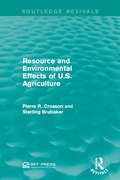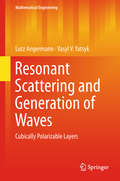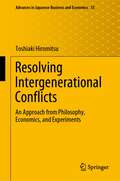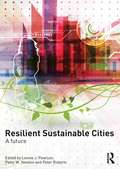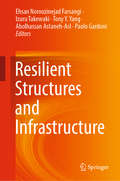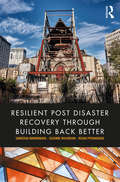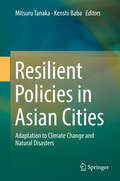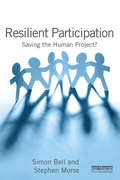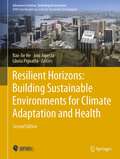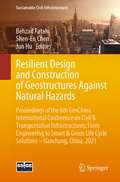- Table View
- List View
Resource and Environmental Effects of U.S. Agriculture (Routledge Revivals)
by Pierre R. Crosson Sterling BrubakerOriginally published in 1982, this report explores long-term trends in demand for U.S. agricultural production, energy prices and agricultural technologies and their effect on natural resources such as land and water in the United States. Crosson and Brubaker also discuss possible policy modifications in order to lessen the environmental impacts expected to emerge from these trends. This title will be of interest to students of Environmental Studies.
Resource Accounting for Sustainability Assessment: The Nexus between Energy, Food, Water and Land Use (Routledge Explorations in Sustainability and Governance)
by Mario Giampietro Richard J. Aspinall Jesus Ramos-Martin Sandra G. F. BukkensThe demands placed on land, water, energy and other natural resources are exacerbated as the world population continues to increase together with the expectations of economic growth. This, combined with concerns over environmental change, presents a set of scientific, policy and management issues that are critical for sustainability. Resource Accounting for Sustainability Assessment: The nexus between energy, food, water and land use offers an approach for multi-scale, integrated assessment of this nexus. It presents a comprehensive and original method of resource accounting for integrated sustainability assessments. The approach is illustrated with three detailed case studies: the islands of Mauritius, the Indian state of Punjab, and the energy economy of South Africa. The relationships between flows of goods, services and materials in these case studies offer valuable insights. The book provides a much needed quality control on the information used in deliberative processes about policy and planning activities. This innovative book will be of interest to researchers, students and practitioners in the fields of sustainability science, international development, industrial ecology, sustainable resource management, geography and ecological economics.
Resource Accounting for Sustainability Assessment: The Nexus between Energy, Food, Water and Land Use (Routledge Explorations in Sustainability and Governance)
by Mario Giampietro Richard J. Aspinall Jesus Ramos-Martin Sandra G.F. BukkensThe demands placed on land, water, energy and other natural resources are exacerbated as the world population continues to increase together with the expectations of economic growth. This, combined with concerns over environmental change, presents a set of scientific, policy and management issues that are critical for sustainability. Resource Accounting for Sustainability Assessment: The nexus between energy, food, water and land use offers an approach for multi-scale, integrated assessment of this nexus. It presents a comprehensive and original method of resource accounting for integrated sustainability assessments. The approach is illustrated with three detailed case studies: the islands of Mauritius, the Indian state of Punjab, and the energy economy of South Africa. The relationships between flows of goods, services and materials in these case studies offer valuable insights. The book provides a much needed quality control on the information used in deliberative processes about policy and planning activities. This innovative book will be of interest to researchers, students and practitioners in the fields of sustainability science, international development, industrial ecology, sustainable resource management, geography and ecological economics.
Resonant Tunneling: Quantum Waveguides of Variable Cross-Section, Asymptotics, Numerics, and Applications (Lecture Notes on Numerical Methods in Engineering and Sciences)
by Lev Baskin Pekka Neittaanmäki Boris Plamenevskii Oleg SarafanovThis volume studies electron resonant tunneling in two- and three-dimensional quantum waveguides of variable cross-sections in the time-independent approach.Mathematical models are suggested for the resonant tunneling and develop asymptotic and numerical approaches for investigating the models. Also, schemes are presented for several electronics devices based on the phenomenon of resonant tunneling.Devices based on the phenomenon of electron resonant tunneling are widely used in electronics. Efforts are directed towards refining properties of resonance structures. There are prospects for building new nano size electronics elements based on quantum dot systems.However, the role of resonance structure can also be given to a quantum wire of variable cross-section. Instead of an "electrode - quantum dot - electrode" system, one can use a quantum wire with two narrows. A waveguide narrow is an effective potential barrier for longitudinal electron motion along a waveguide. The part of the waveguide between two narrows becomes a "resonator" , where electron resonant tunneling can occur. This phenomenon consists in the fact that, for an electron with energy E, the probability T(E) to pass from one part of the waveguide to the other part through the resonator has a sharp peak at E = Eres, where Eres denotes a "resonant" energy. Such quantum resonators can find applications as elements of nano electronics devices and provide some advantages in regard to operation properties and production technology.The book is addressed to mathematicians, physicists, and engineers interested in waveguide theory and its applications in electronics.
Resonant Tunneling: Quantum Waveguides of Variable Cross-Section, Asymptotics, Numerics, and Applications (Lecture Notes on Numerical Methods in Engineering and Sciences)
by Lev Baskin Pekka Neittaanmäki Boris Plamenevskii Oleg SarafanovThis book studies electron resonant tunneling in two- and three-dimensional quantum waveguides of variable cross-sections in the time-independent approach. Mathematical models are suggested for the resonant tunneling and develop asymptotic and numerical approaches for investigating the models. Also, schemes are presented for several electronics devices based on the phenomenon of resonant tunneling. Compared to its first edition, this book includes four new chapters, redistributes the content between chapters and modifies the estimates of the remainders in the asymptotics of resonant tunneling characteristics. The book is addressed to mathematicians, physicists, and engineers interested in waveguide theory and its applications in electronics.
Resonant Scattering and Generation of Waves: Cubically Polarizable Layers (Mathematical Engineering)
by Lutz Angermann Vasyl V. YatsykThis monograph deals with theoretical aspects and numerical simulations of the interaction of electromagnetic fields with nonlinear materials. It focuses in particular on media with nonlinear polarization properties. It addresses the direct problem of nonlinear Electrodynamics, that is to understand the nonlinear behavior in the induced polarization and to analyze or even to control its impact on the propagation of electromagnetic fields in the matter. The book gives a comprehensive presentation of the results obtained by the authors during the last decade and put those findings in a broader, unified context and extends them in several directions.It is divided into eight chapters and three appendices. Chapter 1 starts from the Maxwell’s equations and develops a wave propagation theory in plate-like media with nonlinear polarizability. In chapter 2 a theoretical framework in terms of weak solutions is given in order to prove the existence and uniqueness of a solution of the semilinear boundary-value problem derived in the first chapter. Chapter 3 presents a different approach to the solvability theory of the reduced frequency-domain model. Here the boundary-value problem is reduced to finding solutions of a system of one-dimensional nonlinear Hammerstein integral equations. Chapter 4 describes an approach to the spectral analysis of the linearized system of integral equations. Chapters 5 and 6 are devoted to the numerical approximation of the solutions of the corresponding mathematical models. Chapter 7 contains detailed descriptions, discussions and evaluations of the numerical experiments. Finally, chapter 8 gives a summary of the results and an outlook for future work.
Resolving Intergenerational Conflicts: An Approach from Philosophy, Economics, and Experiments (Advances in Japanese Business and Economics #33)
by Toshiaki HiromitsuThis book is an unprecedented consideration of the challenges of what we can do for generations yet to come. Many growing intergenerational conflicts of interest, such as climate change and fiscal sustainability, are the result of the historically new progress of increasing human power, and the resolution of those conflicts demands a new intergenerational ethic. The book offers fresh new ideas for resolving intergenerational conflicts through the exploration of an entirely new field, conceptualized in philosophy, developed in economics, and tested in experiments. In particular, this work develops the theory of intergenerational cooperation based on a new relationship of direct reciprocity between generations. From experimental results, the possibility of intergenerational cooperation through Kantian categorical imperative is shown. The book also examines the effectiveness of inviting representatives of future generations, which are called "imaginary future generations", into the deliberations for current policy decisions. The original Japanese edition of this book was awarded the 66th Nikkei Prize for Excellent Books in Economic Science. The prize was established in 1958 to contribute to the advancement of academics and knowledge in the fields of economics, management, and accounting, as well as to its general dissemination and application.
Resolving Environmental Conflicts: Principles and Concepts, Third Edition (Social Environmental Sustainability)
by Chris Maser Lynette de SilvaResolving a conflict is based on the art of helping people, with disparate points of view, find enough common ground to ease their fears, sheath their weapons, and listen to one another for their common good, which ultimately translates into social-environmental sustainability for all generations. Written in a clear, concise style, Resolving Environmental Conflicts: Principles and Concepts, Third Edition is a valuable, solution-oriented contribution that explains environmental conflict management. This book provides an overview of environmental conflicts, collaborative skills, and universal principles to assist in re-thinking and acting toward the common good, integrates a variety of new real-world conflicts as a foundation for building trust, skills, consensus, and capacity, and explains pathways to collectively construct a relationship-centric future, fostering healthier interactions with one another and the planet. The new edition illustrates how to successfully mediate actual environmental disputes and how to teach conflict resolution at any level for a wide variety of social-environmental situations. It adds a new chapter on water conflicts and resolutions, providing avenues to healthy, sustainable, and effective outcomes and provides new examples of conflicts caused by climate change with discussion questions for clear understanding. Land-use planners, urban planners, field biologists, and leaders and participants in collaborative environmental projects and initiatives will find this book to be an invaluable resource. University students in related courses will also benefit, as will anyone interested in achieving greater social-environmental sustainability and a more responsible use of our common natural resources for themselves and their children.
Resolving Environmental Conflicts: Principles and Concepts, Third Edition (Social Environmental Sustainability)
by Chris Maser Lynette de SilvaResolving a conflict is based on the art of helping people, with disparate points of view, find enough common ground to ease their fears, sheath their weapons, and listen to one another for their common good, which ultimately translates into social-environmental sustainability for all generations. Written in a clear, concise style, Resolving Environmental Conflicts: Principles and Concepts, Third Edition is a valuable, solution-oriented contribution that explains environmental conflict management. This book provides an overview of environmental conflicts, collaborative skills, and universal principles to assist in re-thinking and acting toward the common good, integrates a variety of new real-world conflicts as a foundation for building trust, skills, consensus, and capacity, and explains pathways to collectively construct a relationship-centric future, fostering healthier interactions with one another and the planet. The new edition illustrates how to successfully mediate actual environmental disputes and how to teach conflict resolution at any level for a wide variety of social-environmental situations. It adds a new chapter on water conflicts and resolutions, providing avenues to healthy, sustainable, and effective outcomes and provides new examples of conflicts caused by climate change with discussion questions for clear understanding. Land-use planners, urban planners, field biologists, and leaders and participants in collaborative environmental projects and initiatives will find this book to be an invaluable resource. University students in related courses will also benefit, as will anyone interested in achieving greater social-environmental sustainability and a more responsible use of our common natural resources for themselves and their children.
Resolving Ecosystem Complexity (MPB-47)
by Oswald J. SchmitzAn ecosystem's complexity develops from the vast numbers of species interacting in ecological communities. The nature of these interactions, in turn, depends on environmental context. How do these components together influence an ecosystem's behavior as a whole? Can ecologists resolve an ecosystem's complexity in order to predict its response to disturbances? Resolving Ecosystem Complexity develops a framework for anticipating the ways environmental context determines the functioning of ecosystems. Oswald Schmitz addresses the critical questions of contemporary ecology: How should an ecosystem be conceptualized to blend its biotic and biophysical components? How should evolutionary ecological principles be used to derive an operational understanding of complex, adaptive ecosystems? How should the relationship between the functional biotic diversity of ecosystems and their properties be understood? Schmitz begins with the universal concept that ecosystems are comprised of species that consume resources and which are then resources for other consumers. From this, he deduces a fundamental rule or evolutionary ecological mechanism for explaining context dependency: individuals within a species trade off foraging gains against the risk of being consumed by predators. Through empirical examples, Schmitz illustrates how species use evolutionary ecological strategies to negotiate a predator-eat-predator world, and he suggests that the implications of species trade-offs are critical to making ecology a predictive science. Bridging the traditional divides between individuals, populations, and communities in ecology, Resolving Ecosystem Complexity builds a systematic foundation for thinking about natural systems.
Resolving Ecosystem Complexity (MPB-47)
by Oswald J. SchmitzAn ecosystem's complexity develops from the vast numbers of species interacting in ecological communities. The nature of these interactions, in turn, depends on environmental context. How do these components together influence an ecosystem's behavior as a whole? Can ecologists resolve an ecosystem's complexity in order to predict its response to disturbances? Resolving Ecosystem Complexity develops a framework for anticipating the ways environmental context determines the functioning of ecosystems. Oswald Schmitz addresses the critical questions of contemporary ecology: How should an ecosystem be conceptualized to blend its biotic and biophysical components? How should evolutionary ecological principles be used to derive an operational understanding of complex, adaptive ecosystems? How should the relationship between the functional biotic diversity of ecosystems and their properties be understood? Schmitz begins with the universal concept that ecosystems are comprised of species that consume resources and which are then resources for other consumers. From this, he deduces a fundamental rule or evolutionary ecological mechanism for explaining context dependency: individuals within a species trade off foraging gains against the risk of being consumed by predators. Through empirical examples, Schmitz illustrates how species use evolutionary ecological strategies to negotiate a predator-eat-predator world, and he suggests that the implications of species trade-offs are critical to making ecology a predictive science. Bridging the traditional divides between individuals, populations, and communities in ecology, Resolving Ecosystem Complexity builds a systematic foundation for thinking about natural systems.
Resilienz komplexer Regionalsysteme: Brunsbüttel zwischen Lock-in und Lernprozessen
by Barbara WeigBarbara Weig schlägt im vorliegenden Buch eine Brücke zwischen Theorie und Empirie, indem sie zunächst das Konzept der Evolutionären Wirtschaftsgeographie kritisch diskutiert und um einen konzeptionellen Ansatz zur Analyse Regionaler Resilienz erweitert. Im zweiten Teil des Buches untersucht die Autorin am Fallbeispiel Brunsbüttel, welches Systemverhalten und welche Systemeigenschaften förderlich und welche hinderlich für den Aufbau von Regionaler Resilienz sind. In Zeiten von Wandel und Unsicherheit ist eine Eigenschaft komplexer Regionalsysteme von besonderer Bedeutung: die Fähigkeit, Resilienz zu entwickeln. Resilienz bedeutet flexibel auf Überraschungen reagieren zu können, anpassungsfähig zu sein und sich endogen weiter zu entwickeln. Dies trifft insbesondere auf regionale Wirtschaftssysteme zu.
Resilient Water Management Strategies in Urban Settings: Innovations in Decentralized Water Infrastructure Systems (Springer Water)
by Tamim Younos Juneseok Lee Tammy E. PareceThis book documents innovative approaches for integrating green technologies and decentralized water infrastructure. The two major components of green decentralized water infrastructure are: (1) using locally available alternative water sources (rainwater, greywater, and brackish/saltwater) (at multiple scales, e.g., a single building to a neighborhood community level); and (2) using renewable energy resources (solar, wind, biomass, geothermal, other). Chapter 1, introduces the concept and framework of green decentralized water infrastructure. The subsequent nine chapters give a detailed description of global case studies, and discuss significant components of the green decentralized water infrastructure and the challenges. The chapters document global case studies and prospects (chapters 1-7) followed by challenges facing decentralized water infrastructure (chapters 8-10). The book will provide a cross-disciplinary knowledge-base for smart & futuristic water management in urban settings and a significant opportunity for sharing smart and decentralized water technologies at the global level
Resilient Urban Regeneration in Informal Settlements in the Tropics: Upgrading Strategies in Asia and Latin America (Advances in 21st Century Human Settlements)
by Oscar Carracedo García-VillalbaThis book focuses on the implementation of slum upgrading projects and the last generation of citywide programmes that define the future urban configuration of informal settlements, from a citywide perspective, in the Earth’s tropical region. The book presents a study on regeneration experiences in Asia and Latin America and it identifies important points of connection and similarities between the two cases, while also determining that, compared to Asia, informality in Latin America is in its ‘second generation.’
Resilient Urban Futures (The Urban Book Series)
by Timon McPhearson Marta Berbés-Blázquez Zoé A. Hamstead David M. Iwaniec Elizabeth M. Cook Tischa A. Muñoz-EricksonThis open access book addresses the way in which urban and urbanizing regions profoundly impact and are impacted by climate change. The editors and authors show why cities must wage simultaneous battles to curb global climate change trends while adapting and transforming to address local climate impacts. This book addresses how cities develop anticipatory and long-range planning capacities for more resilient futures, earnest collaboration across disciplines, and radical reconfigurations of the power regimes that have institutionalized the disenfranchisement of minority groups. Although planning processes consider visions for the future, the editors highlight a more ambitious long-term positive visioning approach that accounts for unpredictability, system dynamics and equity in decision-making. This volume brings the science of urban transformation together with practices of professionals who govern and manage our social, ecological and technological systems to design processes by which cities may achieve resilient urban futures in the face of climate change.
Resilient Sustainable Cities: A Future
by Leonie J. Pearson Peter W. Newton Peter RobertsUrbanization is occurring at an unprecedented rate; by 2050 three quarters of the world’s people will live in urban environments. The cars we drive, products we consume, houses we live in and technology we use will all determine how sustainable our cities will be. Bridging the increasing divide between cross-disciplinary academic insights and the latest practical innovations, Resilient Sustainable Cities provides an integrated approach for long term future planning within the context of the city as a whole system. In the next 30 years cities will face their biggest challenges yet, as a result of long term, or ‘slow burn’ issues: population growth will stretch to the breaking point urban infrastructure and service capacity; resource scarcity, such as peak oil; potable water and food security, will dramatically change what we consume and how; environmental pressures will change how we live and where and; shifting demographic preferences will exacerbate urban pressures. Cities can’t keep doing what they’ve always done and cope – we need to change current urban development to achieve resilient, sustainable cities. Resilient Sustainable Cities provides practical and conceptual insights for practitioners, researchers and students on how to deliver cities which are resilient to ‘slow burn’ issues and achieve sustainability. The book is organized around three overarching themes: pathways to the future innovation to deliver the future leadership and governance issues The book includes a variety of perspectives conveyed through international case studies and examples of cities that have transformed for a sustainable future, exploring their successes and failures to ensure that readers are left with ideas on how to turn their city into a resilient sustainable city for the future.
Resilient Sustainable Cities: A Future
by Leonie Pearson Peter Newton Peter RobertsUrbanization is occurring at an unprecedented rate; by 2050 three quarters of the world’s people will live in urban environments. The cars we drive, products we consume, houses we live in and technology we use will all determine how sustainable our cities will be. Bridging the increasing divide between cross-disciplinary academic insights and the latest practical innovations, Resilient Sustainable Cities provides an integrated approach for long term future planning within the context of the city as a whole system. In the next 30 years cities will face their biggest challenges yet, as a result of long term, or ‘slow burn’ issues: population growth will stretch to the breaking point urban infrastructure and service capacity; resource scarcity, such as peak oil; potable water and food security, will dramatically change what we consume and how; environmental pressures will change how we live and where and; shifting demographic preferences will exacerbate urban pressures. Cities can’t keep doing what they’ve always done and cope – we need to change current urban development to achieve resilient, sustainable cities. Resilient Sustainable Cities provides practical and conceptual insights for practitioners, researchers and students on how to deliver cities which are resilient to ‘slow burn’ issues and achieve sustainability. The book is organized around three overarching themes: pathways to the future innovation to deliver the future leadership and governance issues The book includes a variety of perspectives conveyed through international case studies and examples of cities that have transformed for a sustainable future, exploring their successes and failures to ensure that readers are left with ideas on how to turn their city into a resilient sustainable city for the future.
Resilient Structures and Infrastructure
by Izuru Takewaki Paolo Gardoni Ehsan Noroozinejad Farsangi Tony Y. Yang Abolhassan Astaneh-AslThis book discusses resilience in terms of structures’ and infrastructures’ responses to extreme loading conditions. These include static and dynamic loads such as those generated by blasts, terrorist attacks, seismic events, impact loadings, progressive collapse, floods and wind. In the last decade, the concept of resilience and resilient-based structures has increasingly gained in interest among engineers and scientists. Resilience describes a given structure’s ability to withstand sudden shocks. In other words, it can be measured by the magnitude of shock that a system can tolerate. This book offers a valuable resource for the development of new engineering practices, codes and regulations, public policy, and investigation reports on resilience, and provides broad and integrated coverage of the effects of dynamic loadings, and of the modeling techniques used to compute the structural response to these loadings.
Resilient Post Disaster Recovery through Building Back Better
by Sandeeka Mannakkara Suzanne Wilkinson Regan Potangaroa"Building Back Better" (BBB) has been a popular slogan in disaster recovery efforts around the world, including the 2004 Indian Ocean Tsunami, the 2009 Samoan Tsunami, the 2010 Haiti Earthquake and the 2011 Great East Japan Earthquake. BBB has recently been identified as one of four priorities of action for disaster risk reduction globally in the next 15 years by the United Nations Sendai Framework. However, there has consistently been a mismatch and confusion in the interpretation of the phrase and what BBB encapsulates which has made proper implementation difficult and unsuccessful at times. This book explains the concept of "Building Back Better" as an innovative holistic approach to rebuilding a community following a disaster event in order to develop resilience. It begins by exploring the background, development and definitions of BBB. The theory behind establishing BBB as a holistic concept is explained and the internationally recognised BBB Framework developed by the authors is introduced and described. Each of the components of the Framework are explained in detail with findings from international research and case studies from the US, Haiti, Indonesia, Samoa, Sri Lanka, Vanuatu, Gaza, China, Australia, UK and New Zealand, providing practical recommendations for implementation in recovery projects. There is a focus on the translation of BBB theory into practice to assist implementers to use the BBB Framework and BBB Indicators introduced in this book as an effective tool to plan and implement disaster recovery projects. This publication can be used as a handbook by government, non-governmental and private industry practitioners to prepare for and implement post disaster recovery projects that benefit and strengthen local communities and as a core text on international Disaster and Energy Management courses.
Resilient Post Disaster Recovery through Building Back Better
by Sandeeka Mannakkara Suzanne Wilkinson Regan Potangaroa"Building Back Better" (BBB) has been a popular slogan in disaster recovery efforts around the world, including the 2004 Indian Ocean Tsunami, the 2009 Samoan Tsunami, the 2010 Haiti Earthquake and the 2011 Great East Japan Earthquake. BBB has recently been identified as one of four priorities of action for disaster risk reduction globally in the next 15 years by the United Nations Sendai Framework. However, there has consistently been a mismatch and confusion in the interpretation of the phrase and what BBB encapsulates which has made proper implementation difficult and unsuccessful at times. This book explains the concept of "Building Back Better" as an innovative holistic approach to rebuilding a community following a disaster event in order to develop resilience. It begins by exploring the background, development and definitions of BBB. The theory behind establishing BBB as a holistic concept is explained and the internationally recognised BBB Framework developed by the authors is introduced and described. Each of the components of the Framework are explained in detail with findings from international research and case studies from the US, Haiti, Indonesia, Samoa, Sri Lanka, Vanuatu, Gaza, China, Australia, UK and New Zealand, providing practical recommendations for implementation in recovery projects. There is a focus on the translation of BBB theory into practice to assist implementers to use the BBB Framework and BBB Indicators introduced in this book as an effective tool to plan and implement disaster recovery projects. This publication can be used as a handbook by government, non-governmental and private industry practitioners to prepare for and implement post disaster recovery projects that benefit and strengthen local communities and as a core text on international Disaster and Energy Management courses.
Resilient Policies in Asian Cities: Adaptation to Climate Change and Natural Disasters
by Mitsuru Tanaka Kenshi BabaThis book presents a comprehensive framework and indicators that can be used to assess a city’s degree of resilience. Based on surveys using bottom-up assessment tools, it proposes the concept, framework and indicators of a resilient policy model (including some participatory approaches). It also presents case studies of this and similar tools applied to Japanese and Asian cities, the highlights including information not previously available in English. Today, the term “resilience” is prevalent in the context of sustainable societies. The IPCC AR5 published in 2014 again stressed the impact of climate change on natural disasters, while in March 2015 at the World Conference on Disaster Risk Reduction, the United Nations International Strategy of Disaster Reduction (UNISDR) published the Sendai Framework for Disaster Risk Reduction Action 2015-2030 , which serves as a guideline for local governments. Offering transdisciplinary perspectives from fields such as policy science, urban planning, environmental science, social psychology, management development and geography, this book discusses the lessons learned from Asian case studies, explaining the challenges and the effectiveness of the tools, and offering transdisciplinary insights for policymakers.
Resilient Participation: Saving the Human Project?
by Simon Bell Stephen MorseStakeholder or public participation has become something of a modern mantra employed in all sorts of contexts to give people a voice. There are many variants on this 'participation' but traditionally they all share a desire to maximise involvement and provide desired 'outputs' of a required quality as quickly and as cheaply as possible. Difference tends to be reduced and compromise encouraged as the outputs or even just the appearance of participation are emphasised. This book explores the large and diverse range of participatory methods currently in use, examines the problems and gaps in these methods and sets out an innovative new methodology which overcomes these shortcomings. Uniquely, this method builds from the assumption that it is not just the outputs that matter in participation - it is also the journey. 'Triple Task' is designed to help groups explore their current situation and develop a path by which they can improve their functioning and ultimately make a positive contribution to the lives of others. The book includes in-depth case studies of Triple Task in action across a range of contexts and countries, with particular focus on an EU project concerning indicators in policy-making. This new approach can be used in any context and with any sort of group to help them produce more informative 'outputs' in which a deep reflection of how the group works is allied to an analysis of how problems can be solved.
Resilient Participation: Saving the Human Project?
by Simon Bell Stephen MorseStakeholder or public participation has become something of a modern mantra employed in all sorts of contexts to give people a voice. There are many variants on this 'participation' but traditionally they all share a desire to maximise involvement and provide desired 'outputs' of a required quality as quickly and as cheaply as possible. Difference tends to be reduced and compromise encouraged as the outputs or even just the appearance of participation are emphasised. This book explores the large and diverse range of participatory methods currently in use, examines the problems and gaps in these methods and sets out an innovative new methodology which overcomes these shortcomings. Uniquely, this method builds from the assumption that it is not just the outputs that matter in participation - it is also the journey. 'Triple Task' is designed to help groups explore their current situation and develop a path by which they can improve their functioning and ultimately make a positive contribution to the lives of others. The book includes in-depth case studies of Triple Task in action across a range of contexts and countries, with particular focus on an EU project concerning indicators in policy-making. This new approach can be used in any context and with any sort of group to help them produce more informative 'outputs' in which a deep reflection of how the group works is allied to an analysis of how problems can be solved.
Resilient Horizons: Building Sustainable Environments for Climate Adaptation and Health (Advances in Science, Technology & Innovation)
by Bao-Jie He Joni Jupesta Gloria PignattaThis book discusses the challenges related to climate change mitigation and adaptation. It adds valuable strategies and insights into the development of new practices solving the identified social and economic problems related to ecosystem deterioration and anticipating other disasters related to climate change. As the decarbonization of cities and communities became an issue of great interest to many researchers, the book in hand is of great importance to decision-makers and energy stakeholders and others seeking a more resilient and sustainable future and developing innovative technologies to overcome environmental deterioration. This book is a culmination of selected research papers from the first version of the international conference on ‘Climate Change and Environmental Sustainability’ which was held in 2022 in collaboration with Chongqing University, China.
Resilient Design and Construction of Geostructures Against Natural Hazards: Proceedings of the 6th GeoChina International Conference on Civil & Transportation Infrastructures: From Engineering to Smart & Green Life Cycle Solutions -- Nanchang, China, 2021 (Sustainable Civil Infrastructures)
by Behzad Fatahi Shen-En Chen Jun HuThis volume contains state of the engineering practice and recent research in the field of built infrastructure and natural hazards. It is expected that the book will help engineers and researchers to design and built resilient infrastructures in challenging conditions (e.g., earthquakes and climate change) while optimising the design and minimising the future maintenance cost. In particular new design and construction techniques with reference to major infrastructure projects such as tunneling and transport infrastructure are discussed.
